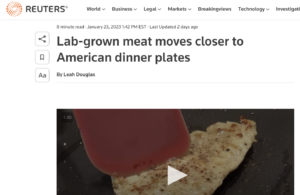WASHINGTON, Jan 23 (Reuters) – Once the stuff of science fiction, lab-grown meat could become reality in some restaurants in the United States as early as this year.
Executives at cultivated meat companies are optimistic that meat grown in massive steel vats could be on the menu within months after one company won the go-ahead from a key regulator.
But to reach its ultimate destination – supermarket shelves – cultivated meat faces big obstacles, five executives told Reuters. Companies must attract more funding to increase production, which would enable them to offer their beef steaks and chicken breasts at a more affordable price. Along the way, they must overcome a reluctance among some consumers to even try lab-grown meat.
Cultivated meat is derived from a small sample of cells collected from livestock, which is then fed nutrients, grown in enormous steel vessels called bioreactors, and processed into something that looks and tastes like a real cut of meat.
Just one country, Singapore, has so far approved the product for retail sale. But the United States is poised to follow. The U.S. Food and Drug Administration (FDA) said in November that a cultivated meat product – a chicken breast grown by California-based UPSIDE Foods – was safe for human consumption.
UPSIDE is now hoping to bring its product to restaurants as soon as 2023 and to grocery stores by 2028, its executives told Reuters.
Regulatory approval is just the first hurdle for making cultivated meat accessible to a broad swath of consumers, executives at UPSIDE, Mosa Meat, Believer Meats, and GOOD Meat told Reuters.
The biggest challenge companies face is growing the nascent supply chain for the nutrient mix to feed cells and for the massive bioreactors required to produce large quantities of cultivated meat, executives said.
For now, production is limited. UPSIDE’s facility has the capacity to churn out 400,000 pounds of cultivated meat per year – a small fraction of the 106 billion pounds of conventional meat and poultry produced in the United States in 2021, according to the North American Meat Institute, a meat industry lobby group.
If the companies cannot get the funds needed to scale up production, their product may never reach a price point where it can compete with conventional meat, said GOOD Meat co-founder Josh Tetrick.
The cultivated meat sector has so far raised nearly $2 billion in investments globally, according to data collected by the Good Food Institute (GFI), a research group focused on alternatives to conventional meat.
Cultivated meat companies plan to pitch consumers that their product is greener and more ethical than conventional livestock, while attempting to overcome an aversion to their product among some shoppers.
Another draw is that growing meat in a steel vessel instead of in a field could reduce the environmental impact of livestock, which are responsible for 14.5% of the world’s greenhouse gas emissions through feed production, deforestation, manure management, and enteric fermentation – animal burps – according to the United Nations’ Food and Agriculture Organization (FAO).
Plant-based meat companies have also appealed to consumers with moral and environmental claims, though the sector has captured just 1.4% of the meat market, according to a GFI report.
Still, a lot of people are grossed out by cultivated meat, said Janet Tomiyama, a health psychologist at the University of California, Los Angeles, who studies human diets.
In a 2022 study published in the Journal of Environmental Psychology, she found that 35% of meat eaters and 55% of vegetarians would be too disgusted to try cultivated meat.
#
The popularity of organic food has skyrocketed in recent years. But when one country decided to go 100% organic … the results were catastrophic.
Our new video explores what it takes to feed a nation. pic.twitter.com/of9VpRJlDE
— Kite & Key Media (@kiteandkeymedia) January 25, 2023



